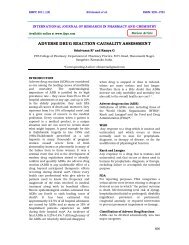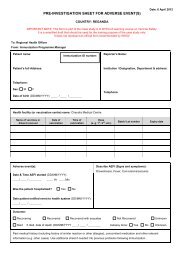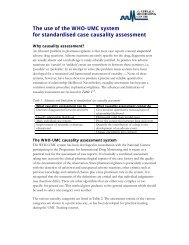00050
Create successful ePaper yourself
Turn your PDF publications into a flip-book with our unique Google optimized e-Paper software.
IJRPC 2011, 1(3) Srinivasan et al. ISSN: 22312781<br />
Post marketing surveillance<br />
Post marketing surveillance can be done by<br />
different methods:<br />
Anecdotal reporting 18<br />
The majority of the first reports of ADR come<br />
through anecdotal reports from individual<br />
doctors when a patient has suffered some<br />
peculiar effect. Such anecdotal reports need to<br />
be verified by further studies and these<br />
sometimes fail to confirm problem.<br />
Intensive monitoring studies 19,24<br />
These studies provide systematic and detailed<br />
collection of data from well defined groups of<br />
inpatients .The surveillance was done by<br />
specially trained health care professionals who<br />
devote their full time efforts towards<br />
recording all the drugs administered and all<br />
the events, which might conceivably be drug<br />
induced. Subsequently, statistical screening for<br />
drug-event association may lead to special<br />
studies. Popular example for this methodology<br />
is Boston collaborative drug surveillance<br />
program.<br />
Spontaneous reporting system (SRS) 20<br />
It is the principal method used for monitoring<br />
the safety of marketed drugs. In UK, USA,<br />
India and Australia, the ADR monitoring<br />
programs in use are based on spontaneous<br />
reporting systems. In this system, clinicians<br />
encourage reporting any or all reactions that<br />
believe may be associated with drug use<br />
usually, attention is focused on new drugs and<br />
serious ADRs. The rationale for SRS is to<br />
generate signals of potential drug problems, to<br />
identify rare ADRs and theoretically to<br />
monitor continuously all drug used in a<br />
variety of real conditions from the time they<br />
are first marketed. 15<br />
Cohort studies (Prospective studies) 19<br />
In these studies, patients taking a particular<br />
drug are identified and events are then<br />
recorded. The weakness of this method is<br />
relatively small number patients likely to be<br />
studied, and the lack of suitable control group<br />
to assess the background incidence of any<br />
adverse events. Such studies are expensive<br />
and it.<br />
Case control studies (retrospective studies) 18<br />
In these studies, patients who present with<br />
symptoms or an illness that could be due to an<br />
adverse drug reaction are screened to see if<br />
they have taken the drug. The prevalence of<br />
drug taking in this group is then compared<br />
with the prevalence in a reference population<br />
who do not have the symptoms or illness. The<br />
case control study is thus suitable for<br />
determining whether the drug causes a given<br />
adverse event once there is some initial<br />
indication that it might. However, it is not a<br />
method for detecting completely new adverse<br />
reactions.<br />
Case cohort studies 18<br />
The case cohort study is a hybrid of<br />
prospective cohort study and retrospective<br />
case control study, Patients who present with<br />
symptoms or an illness that could be due to an<br />
adverse drug reaction are screened to see if<br />
they have taken the drug. The results are then<br />
compared with the incidence of the symptoms<br />
or illness in a prospective cohort of patients<br />
who are taking the drug.<br />
Record linkage 18<br />
The idea here is to bring together a variety of<br />
patient records like general practice records of<br />
illness events and general records of<br />
prescriptions. In this way it may be possible to<br />
match illness events with drugs prescribed. A<br />
specific example of the use of record linkage is<br />
the so called prescription event monitoring<br />
scheme in which all the prescriptions issued<br />
by selected parishioners for a particular drug<br />
are obtained from the prescription pricing<br />
authority. The prescribers are then asked to<br />
inform those running scheme of any events in<br />
the patients taking the drugs. This scheme is<br />
less expensive and time consuming than other<br />
surveillance methods<br />
Meta analysis 21<br />
Meta analysis is a quantitative analysis of two<br />
or more independent studies for the purpose<br />
of determining an overall effect and of<br />
describing reasons for variation in study<br />
results, is another potential tool for identifying<br />
ADRs and assessing drug safety.<br />
Use of population statistics 22<br />
Birth defect registers and cancer registers can<br />
be used If drug induced event is highly<br />
remarkable or very frequent. If suspicions are<br />
aroused then case control and observational<br />
cohort studies will be initiated.<br />
608






